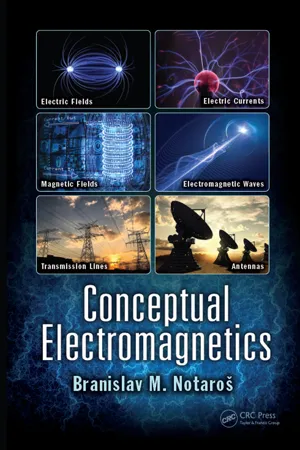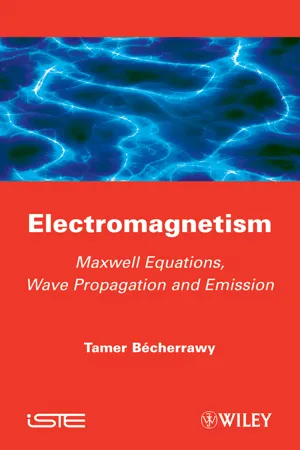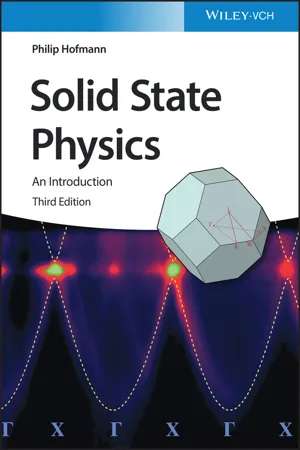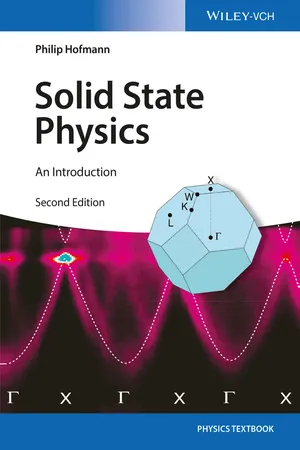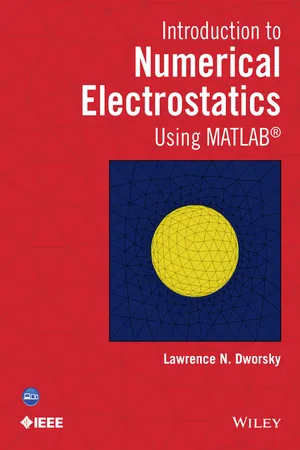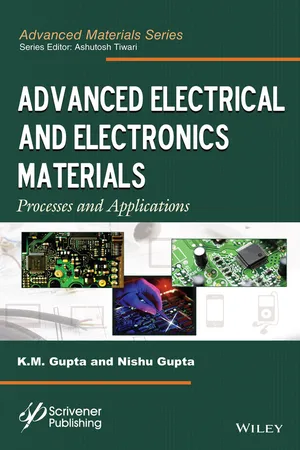Physics
Forces on Dielectrics
When a dielectric material is placed in an electric field, it experiences forces due to the interactions between the electric field and the charges within the dielectric. These forces can lead to the polarization of the dielectric material, causing it to become electrically polarized. The resulting effects on the electric field and the dielectric material's behavior are important in various applications, such as in capacitors and insulators.
Written by Perlego with AI-assistance
Related key terms
Related key terms
1 of 4
Related key terms
1 of 3
11 Key excerpts on "Forces on Dielectrics"
- eBook - ePub
- Branislav M. Notaroš(Author)
- 2017(Publication Date)
- CRC Press(Publisher)
ELECTROSTATIC FIELD IN DIELECTRICS IntroductionDielectrics or insulators are nonconducting materials, having very little free charges inside them (theoretically, perfect dielectrics have no free charges). However, another type of charge, called bound or polarization charges, exist in a polarized dielectric, as atoms and molecules in the dielectric behave like microscopic electric dipoles. In electrostatic systems containing both conductors and dielectrics, the equivalent electric-field sources are both free and bound charges, considered to reside in free space. By introducing the concept of dielectric permittivity, we are left, in turn, to deal with free charges in the system only, while the contribution of bound charges to the field is properly added through the permittivity. In continuation, we analyze capacitors and transmission lines, composed of both conductors and dielectrics, to evaluate and discuss their capacitance, energy, and breakdown characteristics, as a culmination of our study of the theory and applications of the electrostatic field.2.1 Polarization of DielectricsEach atom or molecule in a dielectric is electrically neutral. For most dielectrics, centers of “gravity” of the positive and negative charges in an atom or molecule coincide – in the absence of the external electric field. When a dielectric is placed in an external field, of intensity E, however, the positive and negative charges shift in opposite directions against their mutual attraction, and produce a small electric dipole. The moment of this equivalent dipole is given by p = Qd, where Q is the positive charge of the atom or molecule (−Q is the negative charge), and d is the vector displacement of Q with respect to −Q. The charges are displaced from their equilibrium positions by forces [Eq. (1.3) ] Fe1 = QE and Fe2 = −QE, respectively. The displacement d is very small, on the order of the dimensions of atoms and molecules. The charges Q and −Q are bound in place by atomic and molecular forces and can only shift positions slightly in response to the external field. So, the two charges in an equivalent small dipole cannot separate one from the other and migrate across the material in opposite directions run by the electric field. Hence, these charges are called bound charges (in contrast to free charges). Some dielectrics, such as water, have molecules with a permanent displacement between the centers of the positive and negative charge, so that they act as small electric dipoles even with no applied electric field. According to Figure 2.1 , the torques (moments) of forces Fe1 and Fe2 with respect to the center of the dipole (point O) are T1 = r1 × Fe1 and T2 = r2 × Fe2 , with r1 and r2 denoting the position vectors of Q and −Q with respect to the dipole center. We notice that r1 − r2 = d - eBook - ePub
Integration of Ferroelectric and Piezoelectric Thin Films
Concepts and Applications for Microsystems
- Emmanuel Defaÿ, Emmanuel Defaÿ(Authors)
- 2013(Publication Date)
- Wiley-ISTE(Publisher)
Chapter 5Dielectric Formalism 1
5.1. Introduction
In this chapter we introduce well-established notions about the electric variables of an insulating material. These variables are clear enough for people who know about the physics of solids, but experience shows that the concepts are more difficult to understand in the microsystems community. It therefore seems important to us to dwell at length, just like we did for mechanical energetics, on the electric part in order to introduce the indispensable notions:– the average and local electric field; – electric displacement and polarization; – the relation between field strength and polarization; – the polarization catastrophe phenomenon that appears in perovskites; – dielectric relaxation and the different contributions to polarization characteristic of perovskites; and finally – electric energy density which contributes to internal energy.5.2. The dielectric effect seen by Faraday
Electric charges cross a conductor when a potential difference is applied. In the case of a perfect insulator, charges cannot cross. The dielectric effect observed for the first time by Faraday corresponds to the mutual influence of opposite charges contained in the two electrodes of a plane capacitor. The most telling experiment of this dielectric effect is illustrated in Figure 5.1 . This shows the decrease in potential difference observed between the electrodes of a pre-charged isolated plane capacitor (see Figure 5.1a ) when a dielectric material is introduced in the space between the electrodes (see Figure 5.1b - eBook - ePub
Electromagnetism
Maxwell Equations, Wave Propagation and Emission
- Tamer Becherrawy(Author)
- 2013(Publication Date)
- Wiley-ISTE(Publisher)
Chapter 4Dielectrics
Insulators or dielectrics are mediums that contain no free charges. If a dielectric is placed in an electric field, it becomes polarized. We may consider the electronic polarization as due to the displacement of the electrons within the atoms and molecules and the orientational polarization due to the alignment of the polar molecules more or less in the direction of the electric field. The polarization of dielectrics explains some of their properties, particularly the propagation properties of electromagnetic waves (reflection, refraction, dispersion, etc.). Usually, the polarization disappears if the external field is removed, but some materials, called electrets, retain their polarization. These materials, (generally organic polymers, waxes, etc.) are the electrical analogs of permanent magnets. They are currently used in electrostatic microphones for modern phones. The purpose of this chapter is to study the polarization of dielectrics, the effects of dielectrics on the electric field, the field equations, and the energy.4.1. Effects of dielectric on capacitors
In 1837, Faraday observed that, if a capacitor is maintained under a constant potential (by keeping it connected to a battery) and is filled with a dielectric, its charge is multiplied by a factor εr , which is a characteristic quantity of the dielectric called relative electric permittivity. Thus, the capacitance is multiplied by εr . On the other hand, if an empty capacitor is charged under a potential Vo ( Figure 4.1a ), the plates acquire charge densities ±qs and Gauss’s law gives the field Eo = qs /εo between the plates. If one disconnects the battery and fills the capacitor with the dielectric ( Figure 4.1b ), the charges of the isolated plates remains evidently the same, but the potential difference and hence the field are divided by εr to become[4.1]ε is the absolute permittivity (or the dielectric constant) of the dielectric. The capacitance becomes - eBook - ePub
Solid State Physics
An Introduction
- Philip Hofmann(Author)
- 2022(Publication Date)
- Wiley-VCH(Publisher)
The trouble is that the electric interaction with matter is not necessarily weak and nonlinear effects are often encountered when using strong electric fields, for example, from laser light. This is a very interesting research field in its own right, but we do not discuss it any further here. A standard example used to illustrate the electric polarization is the parallel‐plate capacitor shown in Figure 9.1. For the empty capacitor in Figure 9.1 a, Gauss's law can be used to calculate that the electric field between the plates of size and distance has the constant value, where is the surface charge density on the plates. With this it immediately follows that the capacitance is. When a dielectric material is placed between the plates, it will be polarized by the applied field, leading to the macroscopic polarization. We can imagine this as arising from a very high density of microscopically small electric dipoles (see Figure 9.1 b). The most important effect of these dipoles is that they lead to a net surface charge density where the dielectric meets the plates. When this is taken into account, the resulting average electric field in the capacitor is, that is, it is reduced by a factor of. The capacitance, in contrast, is increased by the same factor. This is often used to determine the value of experimentally. Figure 9.1 A parallel‐plate capacitor. (a) Charges on the plates of the capacitor with no dielectric present between the plates. (b) Polarization of the dielectric material between the plates. (c) The net effect of the polarization is surface charge densities on the dielectric at the plate–dielectric interface. The seemingly simple problem of changing the capacitance of a parallel‐plate capacitor is currently a big challenge in semiconductor device design. Consider the MOSFET in Figure 7.13. The oxide below the gate is in effect the dielectric material in a parallel‐plate capacitor - eBook - ePub
Solid State Physics
An Introduction
- Philip Hofmann(Author)
- 2015(Publication Date)
- Wiley-VCH(Publisher)
9.1 ) represents a limit for weak fields. The trouble is that the electric interaction with matter is not necessarily weak and nonlinear effects are often encountered when using strong electric fields, for example, from laser light. This is a very interesting research field in its own right, but we do not discuss it any further here.A plane plate capacitor. (a) Charges on the plates of the capacitor with no dielectric present between the plates. (b) Polarization of the dielectric material between the plates. (c) The net effect of the polarization is surface charge densities on the dielectric at the plate–dielectric interface.Figure 9.1A standard example used to illustrate the electric polarization is the plane plate capacitor shown in Figure 9.1 . For the empty capacitor in Figure 9.1 a, Gauss's law can be used to calculate that the electric field between the plates of size A and distance d has the constant value , where is the surface charge density on the plates. With this it immediately follows that the capacitance is . When a dielectric material is placed between the plates, it is polarized leading to the macroscopic polarization P. We can imagine this as arising from a very high density of microscopically small electric dipoles (see Figure 9.1 b). The most important effect of these dipoles is that they lead to a net surface charge density where the dielectric meets the plates. When this is taken into account, the resulting average electric field in the capacitor is , that is, it is reduced by a factor of . The capacity, in contrast, is increased by the same factor. This is often used to determine the value of experimentally.The seemingly simple problem of changing the capacitance of a plane plate capacitor is currently a big challenge in semiconductor device design. Consider the MOSFET in Figure 7.13 . The oxide below the gate is in effect the dielectric material in a plane plate capacitor. This capacitor has to be able to store enough charge to make the MOSFET work (without needing too high a gate voltage), that is, it needs a sufficiently large capacitance. The technological goal is to design ever smaller transistors and here the problem sets in. The capacitance is , where is the dielectric constant of the gate oxide . For a decrease in the size of A, C also decreases. This can be compensated by decreasing the thickness of the oxide layer d and this is what the semiconductor industry has been doing for the last 30 years. But now it does not work anymore because d is at its limit (a few nanometers). For an even thinner oxide, the film becomes “leaky” due to tunneling. Therefore, a current field of research is to find a material with a much higher than - eBook - ePub
Dielectrophoresis
Theory, Methodology and Biological Applications
- Ronald R. Pethig(Author)
- 2017(Publication Date)
- Wiley(Publisher)
3 Electric Charges, Fields, Fluxes and Induced Polarization3.1 Introduction
A dielectric can be defined as a material that is a poor conductor of electricity and is capable of supporting an electrostatic field. Other definitions that are given sometimes also include words to the effect that a dielectric becomes polarized when exposed to an electric field. Thus, introductions to the theoretical concepts of dielectric phenomena [e.g., 1] often commence with the scheme shown in Figure 2.1 of Chapter 2, where a voltage potential difference is applied across two parallel metal plates located in a vacuum. The applied potential difference generates a distribution of equal and opposite free electrical charges on the faces of the plates (denoted by symbols +, − in Figure 2.1). The next step is to remove the external voltage source and to replace it with a voltage measuring device, such as an electrometer. The only factor that controls the voltage across the metal plates is the density of free charge on the surfaces of the plates. To ensure that this voltage remains constant and is not affected by the measurement of it, a voltmeter is designed to have a very high resistance to electric current flow. We can therefore ignore any leakage of charge through the electrometer that might reduce the density of positive and negative free charges on the plates. The voltage potential difference across the plates with vacuum between them is measured as V0 . The exercise is then performed of inserting a solid slab of dielectric material into the space between the plates, whilst noting the reading on the electrometer. It is found, as depicted in Figure 3.1 , that the voltage reading falls to a new value V1 . The distance d between the plates remains fixed, so we can assume that the electric field (V/d) between the plates has also dropped from E0 to E1 . The ratio E0 /E1 (or V0 /V1 ) is defined as the relative permittivity r - eBook - ePub
- Anupam Garg(Author)
- 2012(Publication Date)
- Princeton University Press(Publisher)
fig. 15.9 ).99 Models of the dielectric constant
We conclude this chapter by examining how the macroscopic dielectric constant is related to the microscopic properties of the medium. Naturally, this relationship is different for different types of matter, and we will consider only the simplest cases.Nonpolar gases: Suppose a gas composed of nonpolar molecules, such as He or H2 , is placed in an external electric field. A dipole moment is thereby induced in each molecule.FIGURE 15.9. Force on a dipole in the fringing field of a capacitor. It pays to think of the dipole as made up of two opposite charges with a nonzero separation, as shown in the detail on the right. The dipole orients itself parallel to the local field and then feels a net force as shown because of unequal forces on its constituent charges.The field experienced by each molecule consists of the applied field and the dipolar fields due to all the other induced dipoles. However, since the mean intermolecular distances in a gas are large, the dipolar contribution is negligible by comparison,14 and we may take the applied and the actual fields to be the same, E . If the number density of the gas is n and the polarizability of one molecule is α the dipole moment per molecule is α E , the dipole moment per unit volume, or polarization, is P = αn E , and the electric susceptibility isχe= αn. Hence, the dielectric constant isAt STP, the number density n in a gas is 2.69 × 1019 cm−3 , and typical polarizabilities are ~ 1 Å3 (Gaussian). For H, for instance, yielding = 1.00022. Measured values for a variety of gases (table 15.2 ) all show that − 1 10−4 - eBook - ePub
- Ruslan P. Ozerov, Anatoli A. Vorobyev(Authors)
- 2007(Publication Date)
- Elsevier Science(Publisher)
4Dielectric Properties of Substances
Publisher Summary
From the point of view of electric properties, all substances can be divided into two main classes—conducting and nonconducting an electric current. Metals, their alloys, and a small number of chemical compounds with metal character of interatomic interactions relate to the class of conductors. The second class includes other substances and represents the overwhelming majority. Conductivity is defined by the presence of free charge carriers in a substance; their absence determines dielectric properties. So, dielectrics are substances in which there are no free charges capable of covering long distances in the substance. Depending on their molecular structure, all dielectrics can, in turn, be divided into two large groups—polar and nonpolar. In polar dielectrics, molecules themselves represent the electric dipoles with the electric moment; it appears due to displacements of electric charges from positions of their equilibrium in free atoms as a result of chemical bonding. The molecular dipoles of polar dielectrics participate in thermal motion; this can be translational motion (in gases and liquids), oscillation about equilibrium positions (solids and liquids) and rotation around the center of mass. As a result, the dipole electric moments are chaotically distributed along directions.Electric and magnetic interactions play an enormous role in chemistry and chemical technology; they govern the processes taking place in atoms and molecules, crystals, electrolysis, surfaces of solids electrolyzing of dielectric polymer materials and others. Because the electric field in molecular systems has a very complex structure, for the convenience of the reader, we will give the nomenclature of electric fields at the beginning of the chapter. - eBook - ePub
- Michael M. Mansfield, Colm O'Sullivan(Authors)
- 2020(Publication Date)
- Wiley(Publisher)
17 Electric fields in materials; the capacitorAIMS
- to investigate the behaviour of electric charges within and in the neighborhood of conducting materials
- to understand the response of non‐conducting (dielectric) materials to electric fields
- to explore some properties of permanently polarised materials
- to introduce the capacitor, an important component of many electrical circuits
- to show how energy is stored in a capacitor
- to understand what happens when a capacitor is charged or discharged through a resistor
17.1 Conductors in electric fields
In electrostatics the electric field strength within the body of a conductor must always be zero since, if such a field existed, it would have the effect of moving the mobile charges to positions where the electric field, and hence the force on them, would be zero. Thus, there can be no net mobile charge anywhere within the body of a conductor since this would give rise to an electric field; hence all excess charge must reside on the surface of a conductor. The distribution of these charges on the surface of a conductor, therefore, must be such that the net effect is to produce zero electric field everywhere inside the conductor.Consider the case of a body made from a good conductor (such as a metal) placed in an electric field as illustrated in Figure 17.1 . Once the external field is switched on, the mobile charges are driven to the surface and are distributed so that the electric field within the conductor is maintained at zero as required. The electric field lines on the left of the body terminate on the negative charges induced on the surface while the positive charges on the other side of the slab act as sources of field lines on that side.Figure 17.1 - Lawrence N. Dworsky(Author)
- 2014(Publication Date)
- Wiley-IEEE Press(Publisher)
The materials to follow are intended to be a quick review of the relationships that will be used throughout this book. The intent here is to provide a consistent set of notation using all the relationships that will be needed going forward. Many of these relationships are stated without derivation or proof. A more complete electrostatics theory text is recommended for newcomers to the subject. There are very many excellent texts available. The references list at the end of this chapter is certainly not exhaustive, but the texts cited are considered standards in the field.1.1 Charge, Force, and the Electric Field
Electric charges exert forces on one another. This is the basis of electrostatics. The characteristics of these forces are summarized in Coulomb’s law:- Electric charge carries a polarity, or sign. The choice of sign was originally arbitrary, but now is established by tradition—the electron, the most common charged subatomic particle, carries a negative charge.
- For point charges q1 and q2 , measured in coulombs, the (coulomb) force, measured in newtons, in a uniform medium, is given by
(1.1 )
- In equation (1.1 ) and elsewhere ε is the permittivity of the material in farads per meter (F/m). In free space, ε = ε0 = 8.854 F/m. For other linear, isotropic, homogeneous materials, ε = kε0 , where k is the relative permittivity, the relative dielectric constant, or sometimes simply the dielectric constant, of the material. Farads per se are defined as coulombs per volt (C/V). In this book we shall consider only linear, isotropic, homogeneous dielectric materials, and going forward this will be assumed.
- In equation (1.1 ) r is the distance between q 1 and q 2 .
- Also, is a unit vector along the line connecting q 1 and q 2 . If q 1 and q 2 have the same sign, then is pushing q 1 and q 2 apart. If q 1 and q 2 have opposite signs, is pulling them together.
Equation (1.1 ) is expressed in the rationalized meter-kilogram-second (mks) system of units. The derivation of this set of units is an interesting discussion in itself.2When a test charge is in the area of a collection of charges and the magnitude of these latter charges is sufficient, relative to the test charge, to render negligible any perturbation of the situation due to the test charge, then the force on the test charge divided by its charge is defined to be the electric field at that point (typically called the field point). The electric field at (the field point) p due to a charge q- eBook - ePub
Advanced Electrical and Electronics Materials
Processes and Applications
- K. M. Gupta, Nishu Gupta, Ashutosh Tiwari(Authors)
- 2015(Publication Date)
- Wiley-Scrivener(Publisher)
This is then coated with a powder, the powder sticking as a result of electrostatic polarization to the charged areas. Thus, when the drum presses against a sheet of paper, a copy is produced.Example 9.14 Is the behaviour of dielectrics same under d.c. field and a.c. field? If not, how does it differ?Solution. The behaviour of dielectric materials under alternating field is different from the behaviour under static (d.c) field. It is mainly in respect of dielectric constant whose response is frequency dependent. Consequently, the dielectric constant under alternating conditions is a complex quantity whose real part is a measure of dielectric constant and the imaginary part depicts dielectric losses of material.The polarizability p and dielectric constant εrunder static field, take on to complex values p* and εr *; under an applied electric field E0 cos ωt. Here ω is angular frequency of applied field. Thus(9.40)in which the first terms on right side of equations represent real [Re] parts and second terms represent imaginary [Im] parts. Above quantities are different for different mechanisms of polarization processes.Example 9.15 What is polarization vector? How is it related to polarization?Solution. Total polarization P expresses the dipole moment per unit volume of the dielectric material. If there are N number of molecules in this volume, the dipole moment/molecule can be expressed as(9.41)in which the quantity is termed as polarization vector.Example 9.16 Explain the Lorentz expression for internal field.Ans. In case of solids and liquids, the atoms or molecules are closely packed, but in gases it is not so. Therefore in solids and liquids the internal field Ei differs from the applied field E, in contrast to gases where Eiequals to E. In three-dimensional case, the expression for internal field is expressed as(9.42)where P is dipole moment per unit volume and γ is proportionality constant for internal field. Although the value of γ = 1/2/π but in the particular case when the atoms in a solid are surrounded cubically by other atoms, the Lorentz internal field comes into picture. In this case the value of γ = 1/3, therefore
Index pages curate the most relevant extracts from our library of academic textbooks. They’ve been created using an in-house natural language model (NLM), each adding context and meaning to key research topics.
Explore more topic indexes
Explore more topic indexes
1 of 6
Explore more topic indexes
1 of 4
